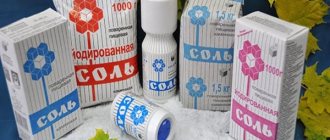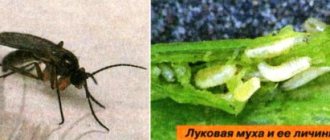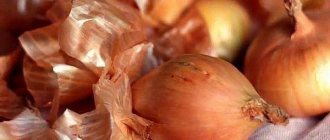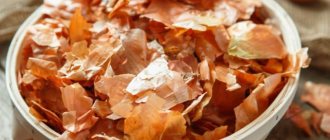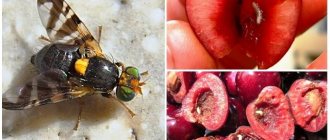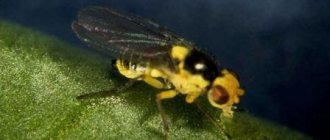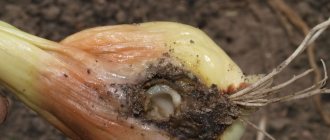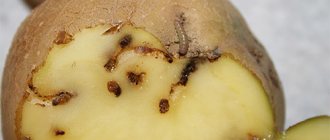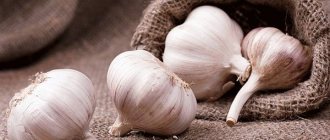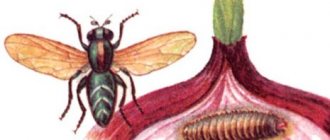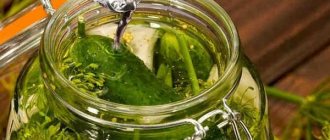This small insect is the most common pest of onions and garlic, and it is not so easy to notice. Therefore, every gardener should be aware of what the onion fly looks like and what means are needed to successfully combat it.
The adult insect is safe for plants because it feeds on nectar and pollen of wild plants. But onion fly larvae are by no means so harmless. The female lays eggs on the leaves of onion and garlic, in the soil next to it, and each individual is capable of producing from 40 to 60 eggs. The development of the egg, depending on weather conditions, lasts from 3 to 8 days, and then the larvae appear, which manage to destroy the entire bulb in the 12-20 days allotted to them. After the larva pupates, the next generation of flies will fly out, and everything will repeat again. In the middle zone, two flights of onion flies occur during the summer.
Description of the pest
Despite its name, the onion fly, in addition to various types of onions (onions, leeks, chives), also damages garlic, some types of lettuce and bulbous flowers (primarily tulips). The pest affects crops not only in open ground, but also in greenhouses.
Appearance and life cycle
The onion fly is an inconspicuous, small (about 7 mm) insect of ash-gray or yellow-gray color. The pest belongs to the order Diptera and is very similar to the common housefly. The wings are transparent and may have two or three longitudinal veins or without them. At the edges of the wings there is a fringe of thin long hairs.
The onion fly is a small insect (7 mm), very similar in appearance to an ordinary housefly
The female lays from 40 to 60 eggs during her life, and from 5 to 20 at a time. Their size is about 1 mm. The eggs are white and have an elongated oval shape. Embryonic development is promoted by high soil moisture (60–80%). After about a week, larvae up to 10 mm in size emerge from them, which immediately penetrate into the bulb. They are legless and white. The body tapers towards the head, which has black mouth hooks. Larvae born from the same clutch stick together and eat away a single cavity inside the bulb.
The fly lays from 5 to 20 eggs at a time, from which, after a week, larvae hatch, which eat the bulbs and feathers
After 15–20 days, the larvae leave the bulbs, crawl into the ground and pupate there, forming a false cocoon. After 2–3 weeks, young flies of the next generation emerge from the pupae. This usually happens in July. In total, two generations of onion fly develop during the season; in the southern regions, under favorable conditions, a third generation may appear. The pest overwinters in the soil of those areas where the larvae developed, at a depth of 5–20 cm in the form of false cocoons.
The onion fly overwinters in the soil at a depth of 5–20 cm in the form of a pupa (false cocoon)
What harm does the onion fly cause?
The period of appearance of the onion fly depends on climatic conditions and varies in different regions from late April to early June. The main landmark for the beginning of the mass emergence of the pest is the moment of flowering of dandelions, lilacs and cherries.
As soon as the cherry blossoms, the gardener must be on alert - the massive flight of the onion fly begins
Adult flies do not eat onions; they feed on pollen from flowering plants. Their harm lies in the fact that females actively lay eggs during the season in the soil, on protruding parts of the bulbs or between the leaves. Fly larvae cause direct harm. They attack onions of the first and second years of development. In seedlings, the larvae damage the feathers. In onions of the second year of growing season, they crawl through the axils of the leaves into the bulb or penetrate it from the bottom, suck out the juice and eat away the pulp, as a result of which the bulbs rot and the plants die.
Causes of defeat
The fight against onion flies that have already appeared can be quite difficult and not always successful. To carry out timely and correct preventive measures, it is necessary to know the reasons for the mass invasion of the pest on onion beds. Among them are:
- violation of crop rotation rules;
- incorrect placement of crops in the garden (poor choice of neighbors);
- late planting of onions;
- lack of deep autumn digging of the soil;
- use of infected and untreated seed material before planting.
Prevention of pest occurrence
Preventing the spread of the pest is always preferable and safer for the crop. You can prevent onion fly damage to plants by taking the following preventive measures:
- Maintaining crop rotation. Planting onions in the same place no earlier than after 3–4 years.
- The correct selection of predecessors and neighbors for onions: carrots, tomatoes, cucumbers, cabbage.
It is recommended to plant carrots next to onions, as their smell repels the onion fly.
- Deep autumn digging of beds intended for planting onions. It is carried out by turning over the layers (autumn plowing) for deeper freezing of the soil so that the false cocoons in it die.
Deep autumn digging of the soil contributes to the death of onion fly larvae
- Pre-treatment of onion sets. It is produced by soaking it before planting in one of the following ways: in hot water at a temperature of 45–46°C for 10–15 minutes, at 50–52°C for 3–5 minutes;
- in a solution of potassium permanganate (1 g/l) for 30 minutes;
- in an aqueous solution of birch tar (1 tablespoon per liter of settled water) for 2–3 hours.
Video: birch tar as a prevention of onion fly
How to care for onions: 5 rules
How to save a bow from an onion fly? First of all, you need to provide it with proper care so that the plant is healthy:
| Rule 1. Observe boarding time Onions are planted in the ground in mid-April, in dry but not hot weather. The size of the bulbs when planting should be 1.5–3 g. Small planting material will give a small harvest, and from a large set the onion can go into arrows. The distance between the bulbs in a row is 7–12 cm | |
| Rule 2. Apply fertilizers Before planting onions, the soil allocated for them must be fertilized with rotted manure and mineral fertilizers, this will help the onions to develop better | |
| Rule 3. Remove weeds To prevent onions from getting sick, you need to periodically loosen the soil under it and weed out the weeds | |
| Rule 4. Water If there has been no rainfall on the site for a long time, the onions need to be watered generously 2-3 times a month. Excessive watering is also harmful to this crop, as is drought. A month before the onions ripen, watering should be stopped, then the bulbs will fully ripen and will be well stored | |
| Rule 5. Harvest on time Onions should be removed from the site after they have turned yellow in dry weather. It needs to be dug up and left in the sun to dry. Bulbs should be stored in a cool, dark place. |
The video explains in detail how to care for onions. These measures will help protect it from diseases and pests, including onion flies:
Chemical treatment for onion flies
In advanced cases, when preventive measures were not taken in a timely manner, chemicals have to be used. Their use is extremely undesirable, since onions tend to accumulate harmful substances and can be dangerous if consumed. When spraying with insecticides, it is necessary to follow the dosage indicated in the instructions, spraying should be carried out in the morning or evening in dry, windless weather, and also maintain the recommended waiting period. After chemical treatments, it is better not to use onion feathers at all.
Ammonia
Ammonia (an aqueous solution of ammonia) is a liquid with a pungent odor that is sold in pharmacies. It is a chemical preparation, but to a greater extent the use of this remedy to combat onion flies can be attributed to folk methods. There are no clear instructions for its use in the sources.
Ammonia with its pungent odor repels onion flies
There are various recommendations regarding the concentration of the solution: from one to five tablespoons per 10 liters of water. It is believed that to use the product for preventive purposes, it is enough to dilute 1–2 tablespoons of the drug; increasing the concentration is recommended if a significant number of plants are affected. Ten liters of solution will be enough to spill 2 m2 of planting. They begin to process the onions during the cherry blossom period, and then do this several more times with an interval of 7–10 days. The beds are first watered with clean water, then with a solution between the onion rows and again with clean water.
Video: ammonia treatment against onion fly
Metronidazole
These are antibacterial tablets used to treat people and can be bought at the pharmacy. Their use as a means of combating onion flies can most likely also be classified as folk remedies. Information about the concentration of the solution varies. The most common dosage is 4 tablets per 10 liters of water, but there are other options - from 5 to 10 tablets for the same amount of water. Metronidazole is used to combat fly larvae. The treatment is carried out once, when the feather has already become stronger and is at least 5 centimeters in height.
Some gardeners use metronidazole to control onion flies.
Reviews about the use of this remedy are contradictory. Some gardeners claim that the drug is effective against onion flies, while others have not received any results from the treatments.
I tried to look for information about watering onions with metronidazole against onion flies on the Internet, but I couldn’t find it, so I’ll share what I did myself. I was told that for 10 liters of water they use 10 metronidazole tablets. True, everyone does it differently; some use 5 tablets per 10 liters of water for irrigation. I decided that I would use the middle option. I crushed 5 tablets and poured the resulting powder into an 8-liter watering can. Stirred and poured the resulting solution on the onions. After 1.5 days, I picked a feather, looked and saw live onion fly larvae in it. I don’t know, either not enough time has passed, or I still needed to use 10 tablets per 10 liters of water, I’ll see what happens next.
Recent Entries
Lilac perennials that are beautiful, compact and do not crowd out other plants Why when buying seedlings you should not take the sellers’ word for it and how to determine the age of the plant using 3 signs Tomato seedlings have turned purple or whitish: why the color has changed and how to save the plants
natla
https:// www.bolshoyvopros.ru/questions/1584569-kak-razvodit-metronidazol-dlja-poliva-luka-ot-lukovoj-muhi-kak-polivat.html
Metronidazole is a controversial drug not only regarding the concentration of the solution and its effectiveness in the fight against onion flies. When diluted with ten tablets in a bucket of water, or even one tablet, it can be hazardous to health.
Zemlin
The popular garden insecticide Zemlin is used during the planting of onions. The toxic activity of the drug lasts up to 60 days. The remedy against onion fly can be applied to the upper layers of the soil symptomatically when it is urgently needed. Zemlin is not toxic to humans. It is produced in the form of granular powder, which is scattered on the soil and then loosened. The consumption rate is 3 g/m2. For a more uniform distribution, the drug is used in a mixture with sand. A half-liter container is filled 3/4 with sand, 30 g of granules are added there and mixed. In case of mass infestation by pests, the drug is used for 2–4 seasons in a row until they disappear completely.
Zemlin is scattered on the beds during planting of onions, its effect lasts up to 60 days
Fly eater
The drug is successfully used to combat insects and onion fly larvae. The fly eater is considered harmless to the soil and beneficial organisms. Thanks to the aromatic bait, the pest eats it and dies within two to three days. After moistening (precipitation or watering), the active substance penetrates the plants and has a poisonous effect on flying insects. Therefore, the fly beetle is not used to treat onion plantings or is added to the soil in advance to withstand the waiting period before eating onion leaves. The drug is produced in the form of granules and is used once before planting onions. Its validity lasts for two months, this period is also a waiting period. The granules are scattered at the rate of 5 g/m2 at an air temperature of no higher than 25°C and the soil is loosened superficially.
The fly eater is effective against onion flies and is harmless to the soil and beneficial organisms
Inta-Vir
The popular and inexpensive insecticide Inta-Vir is moderately toxic and is successfully used by gardeners to combat onion flies. The solution is prepared at the rate of one tablet per 10 liters of water, it is used immediately after preparation. You can treat the beds with a regular watering can or with a spray bottle. Repeated treatment is allowed no earlier than 14 days. You should not eat vegetables for the same amount of time after using the drug. You can do no more than three treatments per season.
Inta-Vir is a popular insecticide with moderate toxicity, successfully used to control onion flies
Alatar
This product destroys almost all pests of garden and garden crops, including onion flies. The inclusion of two active poisons in Alatar provides the drug with a combined mechanism of action on the pest’s body, resulting in high mortality of its large-scale colonies. Alatar can be used twice, maintaining an interval of 10 days between treatments. The drug is used very rarely more than twice. The waiting period is 3 weeks. To prepare a working solution, 5 ml of the drug is diluted in 4 liters of water, this amount is enough to treat 100 m2. Alatar is not washed off by rainwater, and is also resistant to ultraviolet rays and high air temperatures.
Alatar contains two active poisons, which makes the drug highly effective against most pests
Creolin
Reviews about the effectiveness of this drug in the fight against onion flies are positive, even enthusiastic. However, Creolin is recommended to be used as a last resort when other methods do not give the desired result, since the product is very toxic. The drug is a viscous liquid with a pronounced pungent odor and consists of naphthalene, coal oil, and ichthyol. It is used by veterinarians as an antiparasitic agent.
Creolin is very toxic, so it is used with great caution
The instructions for creolin, sold in pharmacies, contain compositions for treating animals and premises against ticks and other parasites. Creolin is not on the list of approved drugs, but it is included in many pesticides. The most common dosage option in sources is 2 tablespoons per 10 liters of water. The first treatment can be carried out when the onion feathers reach a length of 8–10 cm, and repeated treatment after three weeks.
Tips and recommendations from experienced summer residents
Take advantage of some more useful tips from gardeners that will help you avoid mistakes:
- If larvae have already settled in the bulbs, they must be immediately pulled out and destroyed, burned. Never place affected onions in a compost bin.
- A proven method of preventing the appearance of onion flies: 1 tsp. dissolve tar (you can buy it at the pharmacy, it will last for 3-4 years) in 1 liter of water and soak the onion in this solution for about 3 hours before planting. The smell of tar in the garden is almost imperceptible to humans, but it repels pests. Some summer residents grease rags with tar and place them between the rows of onions.
- When adding ash to the soil or watering onions, keep in mind that this product can burn onion roots - strictly follow the dosage.
- If the case is advanced and you cannot do without chemicals, remember that processed onion greens cannot be eaten. Especially if the plants were sprayed.
Folk methods of struggle
The vast majority of folk methods of controlling onion flies have a repellent effect and do not completely destroy the pests. They begin to use them before the insects fly out and, as a rule, the treatment is carried out 2-3 times per season.
Potassium permangantsovka
Potassium permanganate (potassium permanganate or potassium permanganate) is diluted in the proportion of 1 teaspoon per 10 liters of water, the solution should be pink-saturated. Water the beds immediately after planting, and then repeat the treatment after 10 days and again after 7–10 days. It is believed that the product prevents the appearance of onion flies and its larvae, however, there is an opinion that potassium permanganate is effective only in the fight against diseases, and not against pests.
Many gardeners use potassium permanganate to combat onion flies.
Salt
A rather controversial method of combating onion flies is treatment with saline solutions. Its effectiveness against larvae is not in doubt. However, there is a wide variety of recommended dosages for preparing the solution, and there is no consensus regarding the frequency of treatments.
As for the amount of salt that needs to be diluted in 10 liters of water, you can find recommendations from 100 to 600 grams in the sources. The triple treatment technique is often mentioned, which involves increasing the concentration of the saline solution with each subsequent spraying. The first treatment is carried out at the rate of 200–300 g of salt per bucket of water, when the feather reaches 5 cm in height. After 15–20 days, water again with a more saturated solution (350–450 g per 10 liters). The third time is processed after three weeks, using 500–600 g of salt for the same volume of water. During spraying, avoid getting the solution on the onion feathers; 3-4 hours after each treatment, the beds are spilled with clean water.
When describing this method of combating onion fly, it is noted that its use leads to a deterioration in soil quality due to its excessive salinity. It is believed that such treatment can be used no more than once a year.
Table salt effectively destroys onion fly larvae, but at the same time accumulates in the soil and deteriorates its quality
Kerosene
A fairly effective method against onion flies is treatment with a kerosene solution, the specific smell of which will repel the pest. The concentration of the solution is 2–3 tablespoons per 10 liters of water. The first treatment is carried out when the feather grows to 8–10 cm. Water the onion at the root, being careful not to get it on the plants. After a few hours, water the onions generously with clean water. Repeat the treatment twice more with an interval of 10–14 days. It is argued that this method of control is not harmful to human health. You can also use a combined kerosene-salt solution by mixing 2 tablespoons of kerosene and 1 cup of salt in a bucket of water.
Vinegar
Vinegar is also used to combat onion flies. It can be applied in two ways:
- Vinegar essence is diluted in small containers with water (1 tablespoon of essence per 3-4 tablespoons of water) and placed in the inter-rows of onion beds. When the liquid evaporates, especially under the influence of sunlight, a specific smell will spread that repels the pest.
- Spray the onion beds with a vinegar solution at the rate of 1 tablespoon of essence per 10 liters of water.
Vinegar (vinegar essence) is used not only in cooking, it is considered a fairly effective remedy against onion flies
Ash
The onion fly and its larvae die after treating the beds with ash. It is scattered on the beds and the soil is loosened superficially.
To obtain environmentally friendly wood ash, it is necessary to burn natural waste: dry branches, dead weeds, last year's leaves, etc. It is not recommended to use ash obtained from burning construction waste.
A mixture of one glass of wood ash with tobacco dust and ground pepper, taken one teaspoon each, will be more effective. Treatments begin in early May and are repeated 3-4 times with an interval of 7 days. You can also water the onions with an infusion of ash (2 cups per 10 liters of water) with the addition of laundry soap twice a week so that the solution stays on the plants longer.
Remember
- Start fighting the onion fly as soon as you notice it, so that it does not spread throughout all the plantings and destroy up to 80% of your harvest;
- It is important to know the signs of the onion fly in order to destroy it in time: yellowing feathers, a bad smell and slow growth indicate the appearance of a pest in the area.
- Take preventative measures to keep onion flies and other pests away from your plantings.
- Properly care for onions so that they do not become weakened and become less susceptible to disease.
- Use home remedies, as chemicals can be dangerous for you and your pets.
